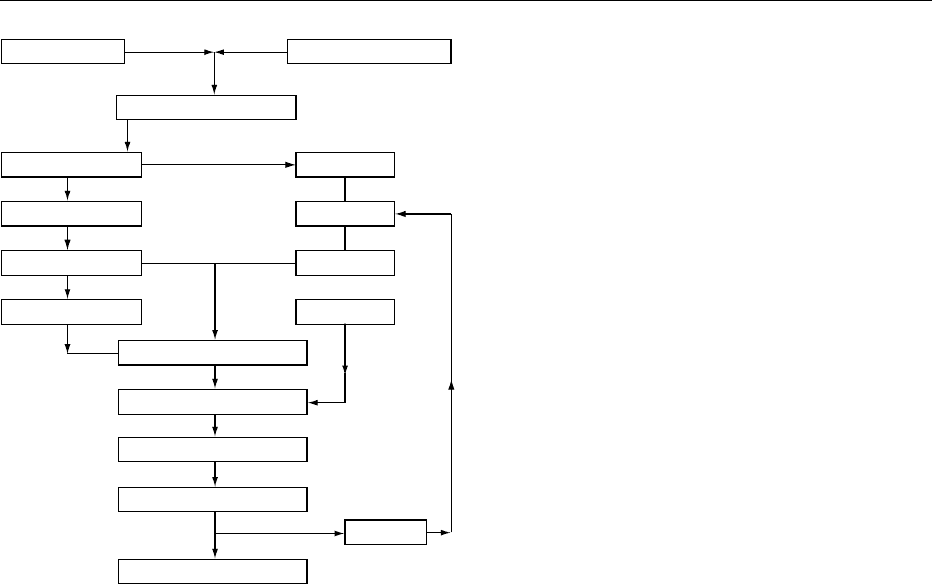Caballero B. (ed.) Encyclopaedia of Food Science, Food Technology and Nutrition. Ten-Volume Set
Подождите немного. Документ загружается.


contents are quite low. This property makes legumes
a natural complement to cereal products, which con-
tain high levels of sulfur amino acids and relatively
low levels of the essential amino acid lysine. In
general, legumes exhibit a large variation in amino
acid content, depending mainly on the environmental
conditions.
0034 Legume protein has often been categorized as poor
and of low biological value. This has mainly been
attributed to the low concentration of sulfur amino
acids and poor digestibility. Besides proteinase inhi-
bitors, the poor digestibility of legumes is caused
by trypsin inhibitors, lectin, tannins, and phytates.
Trypsin inhibitors not only reduce the digestibility of
legume protein but also remove a significant fraction
of cysteine, which is already low. Lectin is a phyto-
hemagglutinin that combines with cells lining the in-
testinal wall and causes nonspecific interference with
absorption of nutrients. Tannins are known to form
complexes with proteins, which decrease the digest-
ibility and amino acid availability. Phytic acid inter-
acts with protein to form phytate–protein complexes
that are insoluble. The most efficient way to improve
the digestibility of legume protein is through heat pro-
cessing. By heating in the presence of water, proteins
can easily denature and become subject to proteolytic
enzymes to aid digestibility. (See Protein: Quality.)
0035 Lipids In general, food legumes tend to have higher
lipid contents than cereals. The lipid content of pulses
ranges from 1 to 7%, while soybeans and peanuts
contain 20–45% lipids. Due to their high lipid con-
tent, soybeans and peanuts are very good sources of
edible oil. The fatty acid composition of legumes
varies, with the predominant fraction being the un-
saturated oleic and linoleic acids. Oils from temper-
ate-zone legumes tend to have more unsaturated fatty
acid components than those of the tropic regions.
Some legumes also contain considerable amounts of
linolenic acid. (See Fats: Occurrence.)
0036 Vitamins and minerals The vitamin content and
availability in legumes vary as a result of both genetic
and environmental factors. Legumes are very good
sources of B vitamins. The thiamin contents of legumes
are usually equivalent to, or higher than, those of
cereal grains. Legumes contain small amounts of ribo-
flavin but tend to be a good source of nicotinic acid.
The pantothenic acid content of legumes is less than
that of cereal grains, but in comparison with most
common foods, legumes are good sources of folic
acid. In general, legumes contain very small amounts
of vitamins.
0037 The mineral content of legumes is in the range of
2.5–4.2%. The most predominant mineral found in
legumes is phosphorus, averaging around 300 mg per
100 g. The calcium and iron contents of legumes are
variable, but in general, legumes are good sources.
Minerals are more concentrated in the seed coat of
legumes than in the cotyledons, but because of the
size of the cotyledon, most of the total mineral con-
tent is found in this fraction.
0038Antinutritional factors The most prevalent antinu-
tritional factors in legumes are those dealing with
protein, but there are also a number of other factors
that decrease the nutritional value of food legumes.
One such factor is the presence of goitrogens in
oilseeds. Goitrogens are thioglycosides or glucosino-
lates that react with iodine and lead to the formation
of goiter in humans. This effect can be counteracted
in soybeans by heating, but not in peanuts. Another
problem with legumes is the presence of mineral che-
lating agents such as phytic and oxalic acid. This can
lead to a decrease in the availability of certain trace
minerals, thus causing anemia. (See Plant Antinutri-
tional Factors: Characteristics.)
0039Cyanogenic glycosides that are naturally present
in legumes can be cleaved by the action of the
b-glucosidase enzyme producing cyanide, which is
a toxicant. Other antinutritional compounds in le-
gumes include a-amylase inhibitors, saponins, aller-
gens, and toxic amino acids that have been known to
exhibit antivitamin and antihormonal activity.
Processing and Food Use of Legumes
Storage of Food Legumes
0040Food legumes are stored at all levels from farmer to
trader in various types of storage units until the next
season’s harvest. Farmers generally retain a portion of
their harvest for family consumption, for seed, and
for animal feed. In developing nations, legume stor-
age is done at the trader and government levels as
insurance against future crops of low yield or poor
quality and against fluctuation in price and market
demand. Losses of legume seeds due to storage are
quite high in comparison to other crops. These losses
are the result of physical, biological, and engineering
factors. Physical factors causing loss are temperature,
moisture, and oxygen concentration. Biological
causes of loss are birds, rodents, insects, mites, bac-
teria, and yeast. Engineering factors resulting in loss
are storage structures and process handling equip-
ment.
Food Uses of Legumes
0041Typically, the leaves, stalks, and seed coats of legumes
are used as animal feed in many underdeveloped
PULSES 4885

countries of the world. These parts of the plant are
generally not used as human food at a household level
but may find use in some bulk products. Humans
usually consume legumes in the form of whole seeds
in a variety of ways. One of the most common ways in
which legume seeds are consumed by humans is in the
form of a dhal. A dhal is a legume seed that has been
physically or mechanically separated at the cotyle-
don, resulting in dehusked, split cotyledons that are
then soaked in water and cooked. Cooked dhals are
seasoned appropriately and consumed with cereal-
based products such as bread or cooked rice.
Seasoning for legume seeds varies considerably by
region, with common seasonings being onion, garlic,
cilantro, green chilies, ginger root, black mustard
seeds, cumin seeds, anise seeds, coriander, and tur-
meric. To prepare these dishes, the seeds and season-
ings are heated separately and then mixed and boiled,
resulting in a soup-like product. In addition to this
common method of consumption, a variety of differ-
ent products are prepared from food legumes.
0042 Soaking legumes in water is often the first step to
prepare the seeds for consumption or processing.
Seeds are usually soaked for up to 24 h to loosen the
hulls and help remove antinutrients such as tannins,
oligosaccharides, and b-glysosides. In many cases,
food legumes are germinated to form sprouts.
Legume sprouts are a very important part of the diet
in the Far East. By germinating legumes, the flavor
and nutritional properties of the seeds are improved
through the breakdown of antinutrients and phytic
acid, which leads to flatulence.
0043 Another legume process traditionally used in
Africa and Asia is milling or removal of the outer
portion of the seed. Milling occurs at all levels from
the home kitchen to large-scale commercial oper-
ations. Prior to milling, legume seeds are often pre-
treated using wet and dry methods to aid in hull
removal. The wet method involves mixing legume
seeds with small amounts of water, followed by
draining and sun drying. The dry method, commonly
used in India, involves sun drying legume seeds that
have been treated with oil and a very small amount of
water. Both methods cause shrinkage of the endo-
sperm, thus loosening the seed coat for easy removal
by milling. The resulting legume flour is used to make
a variety of breads and pastries.
0044 One of the oldest methods of food processing that
is often used with food legumes is fermentation. In
many parts of the world, fermented legume products
serve a very important function in the diet. Most
fermented legume products are widely used in Asia
and India but are rapidly gaining popularity in
the western hemisphere. Legume-based fermented
products are popular because of their texture and
organoleptic characteristics. By fermenting legumes,
it is possible to eliminate undesirable flavor, improve
digestibility, prolong shelf-life, and increase the safety
of the food. Popular legume-based fermented prod-
ucts include soy sauce, shoyu, miso, sufu, natto, and
tempeh. Food legumes are also very popular in the
canning industry. Most of this is the increased popu-
larity of refried beans, soups, and other ready-to-eat
dishes.
Byproduct Processing
0045Whole legumes, although produced and used widely
throughout the world, have a low market value in
comparison to other food commodities. To increase
the value of legumes, some processors isolate func-
tional byproducts from whole seeds. By far the most
popular legume byproduct, due to its high availabil-
ity, is protein. Legume protein concentrates and isol-
ates are prepared by air classification and solvent
solubilization. Air classification is a physical method
in which legume flour is separated by density into a
protein concentrate and a starch-rich fraction. In
solvent solubilization techniques, soluble protein is
removed from insoluble material by centrifugation,
followed by an acid precipitation. Other byproducts
of food legumes include starch and dietary fiber,
which can be used to fortify and increase the func-
tionality of various food products.
See also: Beans; Goitrogens and Antithyroid
Compounds; Legumes: Legumes in the Diet; Dietary
Importance; Peanuts; Peas and Lentils; Plant
Antinutritional Factors: Characteristics; Soy (Soya)
Beans: The Crop
Further Reading
Arora SK (1983) Chemistry and Biochemistry of Legumes.
India: Oxonian Press.
Hedley CL (2001) Carbohydrates in Grain Legume Seeds:
Improving Nutritional Quality and Agronomic Charac-
teristics. New York: CABI.
Huisman J, van der Poel TFB and Liener IE (1988) Recent
advances of research in antinutritional factors in legume
seeds. In: Proceedings of the First International Work-
shop on ‘Antinutritional Factors (ANF) in Legume
Seeds,‘ November 23–25, 1988, Wageningen, The Neth-
erlands.
Matthews RH (1989) Legumes – Chemistry, Technology
and Human Nutrition. New York: Marcel Dekker.
Nwokolo E and Smartt J (1996) Food and Feed from
Legumes and Oilseeds. New York: Chapman & Hall.
Salunkhe DK and Kadam SS (1989) Handbook of World
Food Legumes: Nutritional Chemistry, Processing Tech-
nology, and Utilization, vols. 1–3. Boca Raton, FL: CRC
Press.
4886 PULSES

Salunkhe DK, Kadam SS and Chavan JK (1985) Postharvest
Biotechnology of Food Legumes. Boca Raton, FL: CRC
Press.
Smartt J (1990) Grain Legumes: Evolution and Genetic
Resources. Cambridge: Cambridge University Press.
Sosulski F and Garratt MD (1976) Functional properties of
ten legume flours. Journal of the Canadian Institute of
Food Science and Technology 9: 66–69.
Summerfield RJ and Roberts EH (1985) Grain Legume
Crops. London: Collins Professional and Technical
Books.
Pyridoxine See Vitamin B
6
: Properties and Determination; Physiology
PULSES 4887

Q
Q Fever See Zoonoses
QUALITY ASSURANCE AND QUALITY
CONTROL
P J Molnar, Central Food Research Institute,
Budapest, Hungary
Copyright 2003, Elsevier Science Ltd. All Rights Reserved.
Background
0001 A principal factor in the performance of a food
enterprise is the quality of its products. There is a
worldwide trend towards more stringent customer
expectations with regard to food quality and safety.
Accompanying this trend has been a growing realiza-
tion that continual improvements in quality are often
necessary to achieve and sustain good economic per-
formance.
0002 Today, every customer demands quality from their
supplier. In particular, the last customer in the chain
of suppliers and customers – the consumer – has
increasingly placed vociferous demands on quality
in the sense that (1) the future of the world will not
be endangered by harm to the environment resulting
from food production and (2) the consumer will
suffer no economic damage or injury to health as a
result of the consumption of food components.
Definition and Description of Food Quality
and Safety
0003 The quality of food can be defined as a composite of
characteristics which affect the ability of foods to
satisfy definite requirements and which determine its
fitness for consumption.
0004 Quality in this sense can be discussed under three
headings:
1.
0005Sensory quality, the basic characteristics of which
are the product’s color, appearance, texture, ten-
derness, juiciness, taste, and smell; these charac-
teristics, being easily perceptible, are the basis of
evaluation and preference on the part of con-
sumers. (See Sensory Evaluation: Sensory Charac-
teristics of Human Foods.)
2.
0006Nutritive value, which determines the content
and level of essential nutrients (biological value),
some microbial components (e.g., desirable lactic
bacteria), energy content, dietary value, digest-
ibility, and availability. (See Bioavailability of
Nutrients.)
3.
0007Convenience and technological quality, character-
izing the easy handling and functionality of a food
product, to manufacturers and tradesmen and
then to consumers; these qualities are based on
characteristics such as shelf-life, processing level,
good price–quality relation, durability, ease of
storage and transportation, dimensions, function-
ality, and usefulness in the production of definite
food products. (See Storage Stability: Mechanisms
of Degradation; Parameters Affecting Storage Sta-
bility; Shelf-life Testing.)
Wholesomeness, also called food safety or food
hygiene, may be defined as the result of all condi-
tions and measures that are necessary during the
production, processing, storage, distribution, and
preparation of food to ensure that it is safe, sound,
wholesome, and fit for human consumption. The aim
of all these conditions and measures is to protect the
health of people as consumers and to ensure fair
practice in the food trade.

0008 The wholesomeness of food determines its fitness
for consumption, the classification of which should
be based on specified sanitary criteria. The bases of
these criteria are the assumptions that a food product
must not (1) be harmful to human health, (2) have
undergone deterioration (spoilage), (3) have been
adulterated, and (4) have been produced, distributed,
or stored under improper sanitary or physical condi-
tions.
0009 Factors harmful to food consumers include the
following:
1.
0010 Pathogenic microorganisms and their toxins.
2.
0011 Pathogenic parasites and products of their metab-
olism.
3.
0012 Foreign substances, or their degradation products,
with toxicity to humans. (See Parasites: Occur-
rence and Detection; Spoilage: Bacterial Spoilage;
Molds in Spoilage; Yeasts in Spoilage.)
In relation to pathogenic microorganisms and
parasites, there is an obligatory sanitory rule, which
states that they must not occur in foods owing to their
decisively negative influence on human health. For-
eign substances may be differentiated as follows:
1.
0013 Food additives introduced intentionally to foods
to improve their utilization quality, and
2.
0014Technical and accidental contaminations present
in food as residues resulting from technological
processes or environmental pollution. These in-
clude toxic metals, pesticides, medicines, fodder
supplements (premix), and growth stimulants.
(See Contamination of Food; Food Additives:
Safety.)
The main components of food quality and safety
are shown in Figure 1.
Role of Quality Assurance and Quality
Control
0015Quality assurance can be characterized by the quality
loop for processed food (Figure 2). Quality assurance
is consistent only if the origins of lack of quality are
eliminated, or the emergence of faults is excluded
from the beginning: problems result in, rather than
originate from, exceeded limits of contamination,
adulteration, etc. The quality-assurance system is
based on the following:
1.
0016Product planning and development, including the
results of marketing and market research.
2.
0017Education and training for management and qual-
ity staff as well as for each counterpart.
Overall food quality
Public health safety
Food not
suitable
for human
consumption
Limits exceeded
Hazards too high
Limits not
exceeded
Nutritive value Convenience
Shelf life
Packaging
Processing level
Chemical components
(vitamins, minerals,
dietary fiber, etc.)
Microbial components
(e.g. desired lactic
bacteria)
Energy content
Sensory quality
Appearance
Color
Smell
Texture
Flavor
Food quality
(food suitable for human consumption)
No
hazards
Level of microbial (pathogens
and their toxins)
Parasitic (parasites and their
metabolites)
Toxic and radioactive
contaminants
fig0001 Figure 1 Main components of food quality and safety.
4890 QUALITY ASSURANCE AND QUALITY CONTROL

3.0018 Application of a statistical control method and
sampling inspection plan in process control
and for final inspection.
4.
0019 Responsibility for the quality in each step of the
quality loop.
5.
0020 Use of an information and motivation system on
product quality.
Assisted by the internal quality system of a company
and with additional commitment from the exter-
nal quality partners (suppliers and customers), the
product-oriented quality-assurance system is struc-
tured in the following steps:
1.
0021 Definition of requirements and responsibilities
with regard to the quality of individual activities,
processes, and materials.
2.
0022 Definition of the desired properties and required
parameters of the product.
3.
0023 Definition of materials, technologies, packagings,
storage conditions, number and qualification of
personnel, etc.
4.
0024 Analysis of possible sources of faults and factors
affecting quality.
5.
0025Definition of the quality-assurance actions: infor-
mation, education, training, motivation, param-
eters of investigations, methods of analysis and
sampling documentation, etc.
6.
0026Risk assessment and hazard analysis critical con-
trol point (HACCP).
7.
0027Definition of responsibilities for certain quality-
assurance actions.
Appropriate quality-control procedures should be
part of the process to ensure product safety and qual-
ity and hence part of the company quality assurance
system. Figure 3 shows the quality control of food
manufacturing, including inspection and laboratory
investigation, in a general flow chart.
0028All plant operations should be controlled by writ-
ten procedures and records of performance data. The
range and complexity of procedures vary, depending
upon the size and scope of the operation. However,
management personnel of even the smallest operation
should be aware of the need for quality control con-
sistent with the type of food products being manufac-
tured, stored, or distributed. In larger, more complex
operations, the inspector should determine whether
Quality
evaluation
Quality maintenance
of processed food
Customers
Suppliers
of agricultural
inputs
Agricultural
production
(farming)
Specification
of agricultural
raw material
by specific inputs
Production of
raw material
of specific
quality
Agroprocessing
companies
Quality measurement
of raw material
Grading of
raw material
Impact of processing
technologies on
quality of
processed food
Inspections
of quality of
processed
products
Retailers
Wholesalers
Quality maintenance
of processed food
Quality inspections
of customers
authorities
Customer authorities
in importing country
Quality maintenance
of processed food
Transport and
storage companies
fig0002 Figure 2 Quality loop for processed food: flow of products and flow of information on quality requirements. , main food chain;
background information flow.
QUALITY ASSURANCE AND QUALITY CONTROL 4891

written control procedures exist and should review
records detailing results of quality-control testing
relating to product safety or other factors where regu-
latory requirements exist.
0029 The quality-control department analyses any
planned production changes. Final approval for pro-
duction should not be given until all quality-control
records have been reviewed and properly endorsed by
the quality-control management team.
0030 Laboratory personnel and equipment must be
evaluated to determine whether or not they are
able to carry out all their responsibilities under
the firm’sspecifications and existing regulations.
Laboratory inspection should include spot checks
of in-process controls made by personnel on the
production lines.
Implementation in Food Production (Good
Manufacturing Practice)
0031 The guidelines on good manufacturing practice
(GMP), elaborated and published initially for drugs,
were later modified for human foods and oriented
mainly to food safety. The formulated criteria apply
in determining whether or not the facilities, methods,
practices, and controls used in the manufacture, pro-
cessing, packing, or holding of food conform with, or
are operated or administered in line with, GMP to
ensure that food for human consumption is safe and
has been prepared, packed, and held under sanitary
conditions.
0032More recently, systematic, rule-based approaches
to quality assurance have been widely applied, most
notably that based on the HACCP program. Such
techniques provide ways of applying our current
knowledge of microbial ecology of food in a system-
atic manner to ensure that nothing is overlooked and
that the risk of microbiological food contamination
is minimized. (See Hazard Analysis Critical Control
Point.)
0033The HACCP program includes an assessment of
potential microbiological, chemical, and physical
hazards, prescribes the elimination of avoidable
hazards, and sets tolerances for the hazards that
cannot be eliminated in the processing of food.
It defines the appropriate control measures, the
tests to be carried out, and the criteria for product
acceptance. It gives a rational systematic docu-
mented procedure which can be used for organiz-
ing and implementing the entire quality-assurance
program.
0034However, GMP includes not only food safety, but
also, as a part of the quality-assurance system, the
application of product specifications. The specifica-
tion for a product is usually the description of the
requirements with which the product has to comply.
These can have a regulatory, commercial, or in-house
basis. Specifications are an integral part of product
development, manufacture, marketing, and sales.
From primary producer to the retail trade, each in-
dustry has its own specific requirements in the de-
scription of the following characteristics of their
products:
.
0035name;
.
0036product description;
.
0037specific properties;
.
0038sensory attributes;
.
0039chemical parameters;
.
0040physical data;
.
0041microbiological parameters;
.
0042shelf-life;
.
0043storage conditions;
.
0044packaging and labeling;
.
0045handling;
.
0046proper sampling and test methods.
From a company viewpoint, specifications can have
an internal and external function. The internal func-
tion comprises purchasing criteria, incoming goods
control, and recording of knowledge and information
in a systematic and accessible way. The external func-
tion includes sales criteria, sampling procedures, and
quality control of finished products. It simplifies
Fresh
Purchased raw
Raw material
Wash, sort, trim
Empty containers
Product
Product filler
Container sealing
Raw material
Retorting (processing)
Postretort handling
Warehousing
Sample
Sample
Laboratory
Sample
Closure
fig0003 Figure 3 General flow chart including quality control.
4892 QUALITY ASSURANCE AND QUALITY CONTROL

functional contacts between companies and can serve
as a base for product comparisons. This has led to the
development of quality system standards and guide-
lines that complement relevant product requirements
given in the technical specifications.
0047 The International Standards Organization (ISO)
9000 series of standards set by the ISO embodies a
rationalization of the many and various national ap-
proaches in this sphere which must be applied in
adequate form under the circumstances of the food
industry. According to this standard, an increasing
number of food companies have a quality-assurance
handbook or quality manual covering the following
main topics:
1.
0048 General quality policy.
2.
0049 Description of the quality system and the responsi-
bilities and interrelationships of all operating and
staff functions.
3.
0050 General description of quality planning require-
ments, with specific details for each product
category where appropriate.
4.
0051 Policy requirements for specific elements of the
system (relating to GMP) and procedures which
implement these policies.
The quality manual is of direct benefit not only to the
producer (e.g., cost reduction, help in product liabil-
ity cases, or improved competitively), but also to the
consumer, who will perceive its effect as a high level
of quality that will be produced and maintained by
the application of an integrated and documented
quality-assurance system.
0052 Food-quality and safety programs in many coun-
tries are currently in a period of reevaluation and
change. Risks to consumers resulting from hazards
in food largely depend on the means available to
prevent, eliminate, or reduce the risks to acceptable
levels through the food chain. Management of food-
borne risks in these terms is a complex independent
activity, and risk-management strategies must include
consideration of all options, including general ap-
proaches such as adherence to GMP, good agricul-
tural practice, good veterinary practice, consumer
education, and labeling.
0053 Total quality management (TQM) is a modern
term to describe how firms are becoming more suc-
cessful today. The results of TQM are significant in
productivity gains, unit cost reduction, elimination of
most consumer complaints, and winning consumers
by always giving them what they expect. TQM based
on GMP and HACCP includes quality assurance and
quality control as well as problem-solving by team
work, and by the quality tools, risk management,
cost of quality and rewards.
Implementation in the Food Laboratory
(Good Laboratory Practice)
0054Whereas quality assurance of the work performed by
laboratories was formerly based largely on confi-
dence in the individual laboratory and in individual
members of staff, a more formalized requirement has
recently been developed for factual documentation of
quality in the results of the investigations presented.
In this respect, the work has proceeded largely along
international lines where, for example, the ISO has
been extremely active.
0055Incorrect results from a laboratory may have ser-
ious health or economic consequences as a result of
an unsuitable food incorrectly being assessed as
suitable, or by unnecessary rejection of an acceptable
food. To ensure reliable analytical results and avoid
mistakes, the laboratories must continuously check
and improve the quality of analytical work.
0056The quality manual, which consists of general
advice for ‘quality assurance,’ should be supple-
mented with more detailed regulations for individual
laboratories. Consequently, it is recommended that
each laboratory prepare its own quality-assurance
directives in a quality manual as a supplement to the
general principles. A quality manual is individual and
therefore differs from laboratory to laboratory, and so
each laboratory needs to prepare its own manual.
However, the following information is necessary in
almost every case:
1.
0057Requirements placed on the laboratory: staff
(management, experts, chemists, physicists,
microbiologists, etc.); premises (type and extent
of the activities); apparatus (equipment, instru-
ments, etc.); glassware and plastic equipment;
chemicals, gases, and solvents.
2.
0058Sampling (sampling and sampling staff do not
necessarily belong to the laboratory).
3.
0059Sample reception at the laboratory: marking and
keeping records; storage of samples before
and after analysis.
4.
0060Sample preparation.
5.
0061Selection of methodology.
.
0062Defining method (type I) is one which deter-
mines a value that can only be arrived at in
terms of the method per se and serves for cali-
bration purposes.
.
0063Reference method (type II) is designated where
type I methods do not apply. It should be selected
from type III methods and should be recom-
mended for use in cases of dispute and for cali-
bration purposes.
.
0064Alternative approved method (type III) is one
which meets the criteria required by the Codex
QUALITY ASSURANCE AND QUALITY CONTROL 4893

Committee on Methods of Analysis and Sam-
pling for methods that may be used for control,
inspection, or regulatory purposes.
.
0065 Tentative method (type IV) is one which has
been used traditionally or else has been recently
introduced but for which the criteria required for
acceptance by the Codex Committee on
Methods of Analysis and Sampling have not yet
been determined.
6.
0066 Documentation and reporting: registration; la-
boratory register; analytical documentation; use
of computers and electronic data processing;
method description.
7.
0067 Quality assurance of analytical results: acceptance
criteria for an evaluation of analytical results;
standard substances, recovery tests, and reference
materials; repeated determinations; intercalibra-
tion and collaborative tests; control chart.
The intention with a quality manual is to provide a
general survey of the factors that influence analytical
reliability at the food laboratories. The implementa-
tion of good laboratory practice and the guidelines
should be of value to all the staff working within
the laboratory and should inspire the creation of
efficiently operating quality-assurance systems for
laboratory work within the food companies.
(See Analysis of Food.)
See also: Analysis of Food; Bioavailability of Nutrients;
Contamination of Food; Food Additives: Safety;
Hazard Analysis Critical Control Point; Parasites:
Occurrence and Detection; Sensory Evaluation: Sensory
Characteristics of Human Foods; Spoilage: Bacterial
Spoilage; Molds in Spoilage; Yeasts in Spoilage; Storage
Stability: Mechanisms of Degradation; Parameters
Affecting Storage Stability; Shelf-life Testing
Further Reading
ALINORM 97/9-Rev. 1 (1997) The Application of Risk
Analysis Principles in Codex. Rome: Codex Alimentar-
ius, Food and Agriculture Organization.
ASQC (1986) Food Processing Industry Quality, Control
System Guidelines. Milwaukee, WI: American Society
for Quality Control.
FAO (1990) Manuals of Food Quality Control: 5. Food
Inspection. Rome: Food and Agriculture Organization.
FAO (1995) The Use of Hazard Analysis Critical Control
Point (HACCP) Principles in Food Control. Rome: Food
and Agriculture Organization.
FAO (1997) Risk Management and Food Safety. Rome:
Food and Agriculture Organization.
Gould W A (1992) Total Quality Management for the Food
Industries. Baltimore, MD: CTI.
ISO (1983) ISO Guide 25, EN 45001. Geneva: Inter-
national Standards Organization.
ISO (1994a) ISO 9001 Quality Systems. Model for Quality
Assurance in Design, Development, Production, Instal-
lation and Servicing. Geneva: International Standards
Organization.
ISO (1994b) ISO 9002 Quality Systems. Model for Quality
Assurance in Production, Installation and Servicing.
Geneva: International Standards Organization.
ISO (1994c) ISO 9003 Model for Quality Assurance Final
Inspection and Test. Geneva: International Standards
Organization.
ISO (1994d) ISO 9004 Quality Management and Quality
System Elements. Part 1: Guidelines. Geneva: Inter-
national Standards Organization.
ISO (1994e) ISO 9004 Quality Management and Quality
System Elements. Part 2: Guidelines for Services.
Geneva: International Standards Organization.
Nordic Council of Ministers (1990) Quality Assurance
Principles for Chemical Food Laboratories. Copen-
hagen: Nordic Council of Ministers.
Quarg See Cheeses: Types of Cheese; Starter Cultures Employed in Cheese-making; Chemistry and
Microbiology of Maturation; Manufacture of Extra-hard Cheeses; Manufacture of Hard and Semi-hard Varieties of
Cheese; Cheeses with ‘Eyes’; Soft and Special Varieties; White Brined Varieties; Quarg and Fromage Frais;
Processed Cheese; Dietary Importance; Mold-ripened Cheeses: Stilton and Related Varieties; Surface Mold-
ripened Cheese Varieties
4894 QUALITY ASSURANCE AND QUALITY CONTROL

QUINOA
S A Valencia-Chamorro, Escuela Polite
´
cnica
Nacional, Quito, Ecuador
Copyright 2003, Elsevier Science Ltd. All Rights Reserved.
Introduction
0001 Quinoa is a typical crop of the Andean region. It has
been cultivated since ancient times, and was a staple
food of the Inca empire. However, production of
quinoa was almost completely reduced after the
Spanish conquest; foreign grains were widely pro-
duced instead.
0002 During the 1970s, initial interest in the crop was
increased. At the same time, higher plantation areas
for cultivation of quinoa in South America and new
markets for the grain in the USA and Europe were
developed. Thus, quinoa is now of great interest to
the scientific world, and it may become a food for the
future.
0003 The origin of quinoa and its distribution in the
Andean region have been reviewed, as well as its
actual distribution in North and South America and
Europe. It is important to mention the strong and
dedicated interest in cultivating this grain outside
the borders of the former Inca empire. Classification
of the grain, cultivation practices, and morphology of
the plant have been described.
0004 Quinoa has been recognized as an extremely nutri-
tious grain all over the world thanks to both the high
quantity and good quality of its protein content as
regards its essential amino acid content. Thus, an
extensive review of the chemical composition and
nutritional value of quinoa has been made, including
its main nutritionally disadvantageous factors.
0005 Finally, several traditional and new forms of using
quinoa have been described. Some future perspectives
with regard to the germplasm collection, agronomic
and agricultural practices, postharvest and industrial
uses of this promising grain, which has been called the
‘mother grain,’ have been included.
Origin and Distribution
0006 Quinoa (Chenopodium quinoa, Willd) is an indigen-
ous crop of the Andean region of South America. It is
one of the oldest crops of the American continent.
Archeological findings in northern Chile showed that
quinoa was used prior to 3000 bc. In Ayacucho, Peru,
evidence has been shown that quinoa was cultivated
before 5000 bc.
0007The quinoa plant was widely cultivated in the
entire Andean region, in Colombia, Ecuador, Peru,
Bolivia, and Chile, before the Spanish conquest.
However, habits and traditional foods of natives
were substituted by foreign crops such as wheat and
barley. Therefore, quinoa was cultivated either in
small plantations in rural areas for domestic con-
sumption or as borders for other crops such as
potatoes or maize. For that reason it was classed as
food for poor people.
0008Quinoa is grown in the highlands from 5
Nin
southern Colombia to 30
S in north-eastern Argen-
tina. At sea level, it is cultivated between 36 and 40
S,
in central Chile.
0009In the late 1970s the main production areas of
quinoa were widely described in Colombia, Chile,
the Andean valleys in Peru, Altiplano in Bolivia and
Peru, and the highlands of Ecuador. In Peru and
Bolivia, this crop has been of great importance. It is
cultivated not only for domestic consumption but
also for export. Common efforts made by govern-
ments and research institutes have contributed to
increase the production of quinoa in Andean coun-
tries. The cultivation of quinoa has now spread from
the Andean region to several countries in the world.
In the 1980s, in the USA, quinoa was cultivated in the
Colorado Rockies. Nowadays, it has became a com-
mercial crop. In the UK, in 1989 quinoa was grown
commercially. In Manitoba, Canada, quinoa was
grown for domestic consumption; farmers expected
to have a viable crop for Canada. Quinoa was intro-
duced to Denmark in 1984. Further improvements in
the crop could make quinoa a promising new crop for
European agriculture.
0010In order to promote the regional interchange of the
excellent genetic material of quinoa among research
institutes and universities, an American and Euro-
pean trial of quinoa was undertaken in the late
1990s. In the project, sponsored by the Food and
Agriculture Organization (FAO: regional office for
Latin America and the Caribbean), 25 cultivars
selected from 10 different countries were tested:
eight from Peru, four from Bolivia, two from Ecua-
dor, the UK, Denmark, and Chile respectively, and
one each from Argentina, Brazil, Colombia, and The
Netherlands. The best cultivar from each country
taking part in the experiment was used as a local
control. Therefore, it is expected to be able to iden-
tify, evaluate, and select promissory genotypes of qui-
noa with high yield, and to provide the technological
knowledge of cultivation practices and production of
QUINOA 4895
